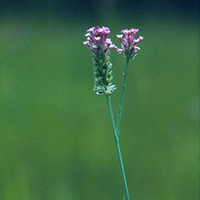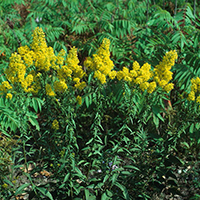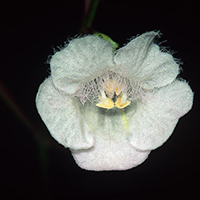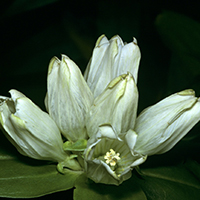Pink Milkwort, Showy Goldenrod (Great Lakes Plains population), Skinner’s Agalinis and White Prairie Gentian government response statement
Ontario’s policy direction for the protection and recovery of Pink Milkwort, Showy Goldenrod (Great Lakes Plains population), Skinner’s Agalinis and White Prairie Gentian.
Publication date: October 28, 2016




Photos: Gary Allen (Pink Milkwort) and Allen Woodliffe (Showy Goldenrod (Great Lakes Plains population), Skinner’s Agalinis, and White Prairie Gentian)
Protecting and recovering species at risk in Ontario
Species at risk recovery is a key part of protecting Ontario’s biodiversity. The Endangered Species Act, 2007 (ESA) is the Government of Ontario’s legislative commitment to protecting and recovering species at risk and their habitats.
Under the ESA, the Ministry of Natural Resources and Forestry (the Ministry) must ensure that a recovery strategy is prepared for each species that is listed as endangered or threatened. A recovery strategy provides science-based advice to government on what is required to achieve recovery of a species.
Within nine months after a recovery strategy is prepared, the ESA requires the Ministry to publish a statement summarizing the government’s intended actions and priorities in response to the recovery strategy. The response statement is the government’s policy response to the scientific advice provided in the recovery strategy. In addition to the strategy, the government response statement considered (where available) input from stakeholders, other jurisdictions, Indigenous communities and organizations, and members of the public. It reflects the best available local and scientific knowledge, including Traditional Ecological Knowledge, at this time and may be adapted if new information becomes available. In implementing the actions in the response statement, the ESA allows the Ministry to determine what is feasible, taking into account social and economic factors.
The recovery strategies for the Pink Milkwort (Polygala incarnata), Showy Goldenrod (Solidago speciosa) (Great Lakes Plains population), Skinner’s Agalinis (Agalinis skinneriana), and White Prairie Gentian (Gentiana alba), in Ontario were completed on January 28, 2016. A multi-species approach is being used to efficiently develop the government response statement for these species based on the common geographic distribution and common threats to the species.
Pink Milkwort is a slender annual herb that measures between 20 and 40 cm in height. Its flowers are tubular, rose-purple in colour, and densely clustered.
Showy Goldenrod (Great Lakes Plains population) is a large perennial herb with stems of the plant growing between 60 and 150 cm in height. Its flower cluster is cylindrical, consisting of many small bright yellow heads.
Skinner’s Agalinis is a pale green, slender, annual herb that measures between 5 and 35 cm in height. Its flowers are funnel shaped, white to very pale pink, and bloom for about a half a day.
White Prairie Gentian is a herbaceous perennial plant, with flowering stems between 30 and 90 cm in height. Its flowers are a greenish-white to yellowish-white, closed bottle-shaped, and clustered at the top of each stem.
Protecting and recovering Pink Milkwort, Showy Goldenrod (Great Lakes Plains population), Skinner’s Agalinis, and White Prairie Gentian
The Pink Milkwort, Showy Goldenrod (Great Lakes Plains population), Skinner’s Agalinis, and White Prairie Gentian are all listed as endangered species under the ESA, which protects both the plants and their habitat. The ESA prohibits harm or harassment of the species and damage or destruction of their habitat without authorization. Such authorization would require that conditions established by the Ministry be met.
Pink Milkwort
In North America, Pink Milkwort is most common in the central plains and along the southeastern seaboard states. The species is near the northern edge of its range in Ontario where there are potentially four existing populations of Pink Milkwort in southwestern Ontario: three populations occur in Bkejwanong (Walpole Island First Nation) which lies on the delta of the St. Clair River as it opens into Lake St. Clair and one population occurs in Ojibway Prairie Provincial Nature Reserve in Windsor-LaSalle. During surveys completed in 2008, plants could not be located at one population in Bkejwanong (Walpole Island First Nation). In 2008, the remaining three populations contained an estimated 1,800 plants. Additional previously known populations on Squirrel Island, near Niagara Falls and at Leamington are presumed to be extirpated.
Showy Goldenrod (Great Lakes Plains population)
The global range of this perennial plant extends from Ontario, Canada, throughout much of the eastern United States and the central Great Plains. There are two existing populations that occur in Bkejwanong (Walpole Island First Nation) in southern Ontario. Surveys performed in 2003 indicated that these two populations contained approximately 1,300 plants. One additional population in Perth County is considered extirpated and an additional three populations that occur in Bkejwanong (Walpole Island First Nation) and at Port Franks are considered likely extirpated.
Skinner’s Agalinis
The global range of Skinner’s Agalinis extends from Ohio and southwestern Ontario west to Minnesota and south to Oklahoma, Louisiana and Tennessee, with populations in Maryland as well. In Ontario, Skinner’s Agalinis has been documented at six populations in Bkejwanong (Walpole Island First Nation) and in Reaume Prarie within Essex County. Of these, only two of these populations are known to still exist and are located in Bkejwanong (Walpole Island First Nation). Surveys performed in 2008 found approximately 23,000 plants at these two populations. The populations of Skinner’s Agalinis can have large year-to-year population fluctuations, and 2008 was thought to have ideal germination and growth conditions as a result of high water levels that year. Three populations in Bkejwanong (Walpole Island First Nation) and one in Reaume Prairie have not been recently observed, despite search efforts in 2008. However, suitable habitat may exist at some of these locations, and the status of these populations requires further investigation.
White Prairie Gentian
White Prairie Gentian has a range that is centred in the plains of the American mid-west with scattered populations in other states and in southern Ontario. The species range is very restricted in Ontario. One population of White Prairie Gentian currently exists in Ontario in Bkejwanong (Walpole Island First Nation). The population was estimated in 2008 to be approximately 100 flowering stems among three subpopulations. Historically, the species occurred in two other areas of Ontario in Northumberland County and Essex County, but has not been observed since the 1800s.
Pink Milkwort, Showy Goldenrod (Great Lakes Plains population), Skinner’s Agalinis, and White Prairie Gentian
Pink Milkwort, Showy Goldenrod (Great Lakes Plains population), Skinner’s Agalinis, and White Prairie Gentian experience similar threats based on the overlap in the areas that they inhabit. All four species occur in prairies that range in moisture condition from wet-mesic to dry, and occur in open conditions. Additionally, White Prairie Gentian may be found in savannahs and alvars, and Showy Goldenrod (Great Lakes Plains population) occurs in Black Oak savannah.
The species are all threatened by a loss of suitable habitat, primarily as a result of human activities. These threats include agricultural expansion, development, all-terrain vehicles use, trampling by pedestrians during recreational usage, and introduction of invasive species. Furthermore, alteration of the natural fire regime in their habitat by suppression of fire is a major threat to all four species. Periodic fire is required to maintain open prairie conditions, and suppression of the natural fire regime can limit suitable habitat by allowing encroachment of woody vegetation such as trees and shrubs to shade out the species. An additional risk to White Prairie Gentian is the threat of hybridization with Closed Bottle Gentian (Gentiana andrewii) which may impact the genetic integrity of the species.
Pink Milkwort, Showy Goldenrod (Great Lakes Plains population), Skinner’s Agalinis, and White Prairie Gentian occur in a small number of geographically-isolated populations. As a result, these populations are susceptible to the impacts of random events. Reducing threats and enabling increases to the extent of suitable habitat at locations where the species occur may support increases to the populations and improve the resiliency of populations. With respect to Pink Milkwort, reducing threats to the species and their habitat may not be enough to ensure its persistence. The population of Pink Milkwort at Ojibway Prairie Provincial Nature Reserve consisted of nine plants in 2008, and additional recovery efforts may be necessary to ensure the species perseverance at this location. Furthermore, some species such as Skinner’s Agalinis and Pink Milkwort are annual species and may experience year-to-year population fluctuations, making it difficult to detect trends in populations. Approaches to recovery will include protecting the species and their habitat, managing threats and implementing best management practices in collaboration with local landowners, partners, and Indigenous communities and organizations. In addition, they will include filling knowledge gaps, by conducting monitoring to determine population trends, and conducting research on the species' biology and threats. All four species occur almost entirely on Bkejwanong (Walpole Island First Nation). Collaborating with local partners and community members and organizations in Bkejwanong (Walpole Island First Nation) to continue to increase local awareness and continue stewardship efforts will be vital to achieving the government’s recovery goal for the species.
Government’s recovery goal
The government’s goal for the recovery of the Pink Milkwort, Showy Goldenrod (Great Lakes Plains population), Skinner’s Agalinis, and White Prairie Gentian is to maintain current population levels of the species in Ontario, to maintain the presence of the species at locations where they occur, and where feasible, enable natural increases in abundance of the species by reducing threats to the species and their habitat. The government supports investigating the feasibility of augmenting the existing populations of White Prairie Gentian and Pink Milkwort at appropriate locations.
Actions
Protecting and recovering species at risk is a shared responsibility. No single agency or organization has the knowledge, authority or financial resources to protect and recover all of Ontario’s species at risk. Successful recovery requires inter-governmental co-operation and the involvement of many individuals, organizations and communities. In developing the government response statement, the Ministry considered what actions are feasible for the government to lead directly and what actions are feasible for the government to support its conservation partners to undertake.
Government-led actions
To help protect and recover the Pink Milkwort, Showy Goldenrod (Great Lakes Plains population), Skinner’s Agalinis, and White Prairie Gentian, the government will directly undertake the following actions:
- Continue to manage the habitat of Pink Milkwort in Ojibway Prairie Provincial Nature Reserve to maintain the ecological integrity of its habitat and to minimize the threat of recreational pressures and impacts.
- Continue to implement the Ontario Invasive Species Strategic Plan to address the invasive species (e.g., European Common Reed (Phragmites australis ssp. australis), Black Locust (Robinia pseudoacacia), White Sweet Clover (Melilotus albus), and Canada Thistle (Cirsium arvense)) that threaten Pink Milkwort, Showy Goldenrod (Great Lakes Plains population), Skinner’s Agalinis, and White Prairie Gentian.
- Co-operate with federal partners, such as Environment and Climate Change Canada, to implement protection and recovery actions, where appropriate.
- Educate other agencies and authorities involved in planning and environmental assessment processes on the protection requirements under the ESA.
- Encourage the submission of Pink Milkwort, Showy Goldenrod (Great Lakes Plains population), Skinner’s Agalinis, and White Prairie Gentian data to the Ministry’s central repository at the Natural Heritage Information Centre.
- Undertake communications and outreach to increase public awareness of species at risk in Ontario.
- Protect the Pink Milkwort, Showy Goldenrod (Great Lakes Plains population), Skinner’s Agalinis, and White Prairie Gentian and their habitat through the ESA.
- Develop direction to provide greater clarity to proponents and partners on the areas of general habitat protected under the ESA for plant species at risk.
- Support conservation, agency, municipal and industry partners, and Indigenous communities and organizations to undertake activities to protect and recover the Pink Milkwort, Showy Goldenrod (Great Lakes Plains population), Skinner’s Agalinis, and White Prairie Gentian. Support will be provided where appropriate through funding, agreements, permits (including conditions) and/or advisory services.
- Encourage collaboration, and establish and communicate annual priority actions for government support in order to reduce duplication of efforts.
Government-supported actions
The government endorses the following actions as being necessary for the protection and recovery of the Pink Milkwort, Showy Goldenrod (Great Lakes Plains population), Skinner’s Agalinis, and White Prairie Gentian. Actions identified as "high" will be given priority consideration for funding under the ESA. Where reasonable, the government will also consider the priority assigned to these actions when reviewing and issuing authorizations under the ESA. Other organizations are encouraged to consider these priorities when developing projects or mitigation plans related to species at risk. The government will focus its support on these high-priority actions over the next five years.
Focus area: Monitoring
Objective: Enhance knowledge of Pink Milkwort, Showy Goldenrod (Great Lakes Plains population), Skinner’s Agalinis, and White Prairie Gentian distribution, abundance and Traditional Ecological Knowledge in Ontario.
There are some populations of Pink Milkwort, Showy Goldenrod (Great Lakes Plains population), Skinner’s Agalinis, and White Prairie Gentian where the presence of the species has not been recently confirmed or the species is suspected to no longer exist. Confirming the presence or absence of the species at these locations will help to determine where recovery efforts should be focused. Furthermore, implementing a long-term monitoring program will track if current population levels of the species in the province are being maintained. The monitoring program should be developed to target multiple species when they occur at the same site to create efficiencies.
Actions:
- (High) Develop and implement a standardized long-term monitoring program at locations where Pink Milkwort, Showy Goldenrod (Great Lakes Plains population), Skinner’s Agalinis, and/or White Prairie Gentian occur. As appropriate, the monitoring program should target multiple species at risk plants that occur in the same locations (e.g., Dense Blazing Star (Liatris spicata)). The monitoring program will aim to:l
- monitor population trends demographics, reproductive success and habitat conditions; and,
- assess and monitor all known threats and potential threats to populations.
- (High) Conduct surveys to confirm the presence or absence of Pink Milkwort, Showy Goldenrod (Great Lakes Plains population), Skinner’s Agalinis, and/or White Prairie Gentian populations at suitable habitat in historic locations and locations where the continued presence of the species are unknown.
- Encourage the recording, sharing and transfer of Traditional Ecological Knowledge on Pink Milkwort, Showy Goldenrod (Great Lakes Plains population), Skinner’s Agalinis, and White Prairie Gentian including information on the historical distribution of the species and their habitat to support a local ecosystem approach to managing species at risk. Coordinate the collection of Traditional Ecological Knowledge on other species at risk which occur in the same ecosystem (e.g., Small White Lady’s-slipper and Dense Blazing Star).
Focus area: Management and protection
Objective: Work collaboratively to support Bkejwanong (Walpole Island First Nation) community members and other interested Indigenous communities and organizations, landowners, and land managers in protecting and managing Pink Milkwort, Showy Goldenrod (Great Lakes Plains population), Skinner’s Agalinis, and White Prairie Gentian habitat and reducing the threats to the species.
Habitat loss and degradation is a primary threat to Pink Milkwort, Showy Goldenrod (Great Lakes Plains population), Skinner’s Agalinis, and White Prairie Gentian. Given that the species occur primarily on Bkejwanong (Walpole Island First Nation), taking a collaborative approach to implementing best management practices will help to enable the sharing of lessons learned, reduce threats and increase the extent of suitable habitat.
Actions:
- (High) Collaboratively work with Bkejwanong (Walpole Island First Nation) community members and other interested Indigenous communities and organizations, landowners, and land managers to develop, implement, and evaluate best management practices to improve habitat suitability and minimize impacts to the species and their habitat. Efforts should be made where appropriate to coordinate efforts with other prairie plant (e.g., Dense Blazing Star, Small White Lady’s-slipper (Cypripedium candidum)) initiatives. Actions may include:
- using appropriately timed prescribed burns to maintain suitable habitat conditions and minimize impacts to the plants;
- removing invasive species (e.g., European Common Reed, White Sweet Clover, Black Locust) posing a direct threat to Pink Milkwort, Showy Goldenrod (Great Lakes Plains population), Skinner’s Agalinis, and White Prairie Gentian;
- protecting populations by redirecting recreational activities (e.g., all-terrain vehicles or hiking) through the use of signage and fencing, as appropriate; and,
- monitoring the species' and habitat response to prescribed burns and invasive species control to inform adaptive implementation of management approaches.
- As opportunities arise, support the securement of Pink Milkwort, Showy Goldenrod (Great Lakes Plains population), Skinner’s Agalinis, and White Prairie Gentian habitat that exists on privately owned lands through existing land securement and stewardship programs.
Focus area: Research
Objective: Increase knowledge of Pink Milkwort, Showy Goldenrod (Great Lakes Plains population), Skinner’s Agalinis, and White Prairie Gentian population dynamics, ecology and genetics.
There are significant knowledge gaps that exist for each species and the degree of research completed on each species may vary. Filling knowledge gaps relating to the species' ecology such as seed dispersal, seed viability, genetics, and pollination, as well as responses to habitat alterations will provide information to assist in determining minimum viable population sizes and inform the implementation of recovery actions.
There is one small population of Pink Milkwort that occurs on provincial lands with low population numbers, reproduction and viability concerns. Further information is needed on the habitat and recovery potential of the species at this site to inform potential future recovery actions. The extent that hybridization may be occurring or threatening the population of White Prairie Gentian is not known. Research into the extent of this threat, as well as investigating management approaches to conserve Ontario’s only population of the species is needed.
Actions:
- Research Pink Milkwort, Showy Goldenrod (Great Lakes Plains population), Skinner’s Agalinis, and White Prairie Gentian life history characteristics and responses to habitat management activities to help inform the implementation of recovery actions for the species. This may include:
- studying factors that impact establishment and distribution such as seed dispersal and seed viability;
- conducting a population viability analysis;
- addressing information gaps related to the pollination of Pink Milkwort, Skinner’s Agalinis and White Prairie Gentian;
- identifying the unknown moth (Coleophora) species predating Showy Goldenrod (Great Lakes Plains population) seeds, and determine the frequency and the severity of this threat;
- studying germination rates and ideal germination conditions for Pink Milkwort; and,
- studying Pink Milkwort’s response to changes in hydrology (e.g., changes as a result of dredging or ditching operations). Use the results to develop and inform best management practices as appropriate.
- Investigate the feasibility of augmenting Pink Milkwort at appropriate locations (e.g., Ojibway Prairie Provincial Nature Reserve), where suitable habitat is available.
- Conduct research to examine the threat of hybridization and inform population management activities by:
- researching the extent of hybridization between White Prairie Gentian and other types of gentians such as Closed Bottle Gentian. If appropriate, studying the effectiveness and implications of control procedures (e.g., selective removal) of Closed Bottle Gentian to help inform the development of best management practices;
- studying the feasibility and necessity of preserving genetic material from the Ontario population of White Prairie Gentian; and,
- investigating the feasibility of augmenting White Prairie Gentian at existing locations using appropriate genetic material, where suitable habitat exists.
Focus area: Awareness
Objective: Increase local awareness of the species, habitat requirements, and how to minimize threats to Pink Milkwort, Showy Goldenrod (Great Lakes Plains population), Skinner’s Agalinis, and White Prairie Gentian.
Community members, land managers, and land owners where the species occur all have a vital role to play to in reducing threats to all four species. By continuing to increase local awareness, and build on awareness efforts completed by Bkejwanong (Walpole Island First Nation) community members and organizations, individuals will become more knowledgeable about the types of activities that may inadvertently impact the species and how modifying these activities can help to protect these species.
Actions:
- Increase local awareness among land owners, land managers and interested Indigenous communities and organizations, including Bkejwanong (Walpole Island First Nation) community members and organizations, as appropriate, and promote community involvement by developing and distributing information on the Pink Milkwort, Showy Goldenrod (Great Lakes Plains population), Skinner’s Agalinis, and White Prairie Gentian, such as:
- how to identify the species;
- the species' habitat requirements;
- actions that individuals can take to minimize threats to the species and their habitats; and,
- to report occurrence information.
Implementing actions
Financial support for the implementation of actions may be available through the Species at Risk Stewardship Program. Conservation partners are encouraged to discuss project proposals related to the actions in this response statement with the Ministry. The Ministry can also advise if any authorizations under the ESA or other legislation may be required to undertake the project.
Implementation of the actions may be subject to changing priorities across the multitude of species at risk, available resources and the capacity of partners to undertake recovery activities. Where appropriate, the implementation of actions for multiple species will be co-ordinated across government response statements.
Reviewing progress
The ESA requires the Ministry to conduct a review of progress towards protecting and recovering a species not later than five years from the publication of this response statement. The review will help identify if adjustments are needed to achieve the protection and recovery of the Pink Milkwort, Showy Goldenrod (Great Lakes Plains population), Skinner’s Agalinis, and White Prairie Gentian.
Acknowledgement
We would like to thank all those who participated in the development of the recovery strategies for the Pink Milkwort (Polygala incarnata), Showy Goldenrod (Solidago speciosa) (Great Lakes Plains population), Skinner’s Agalinis (Agalinis skinneriana), and White Prairie Gentian (Gentiana alba) in Ontario for their dedication to protecting and recovering species at risk.
For additional information
The government response statement for Pink Milkwort, Showy Goldenrod (Great Lakes Plains population), Skinner’s Agalinis, and White Prairie Gentian is available in PDF format upon request. Please email PDF requests to recovery.planning@ontario.ca.